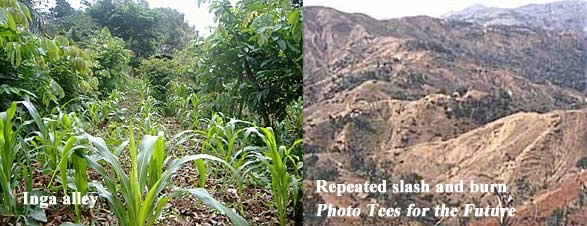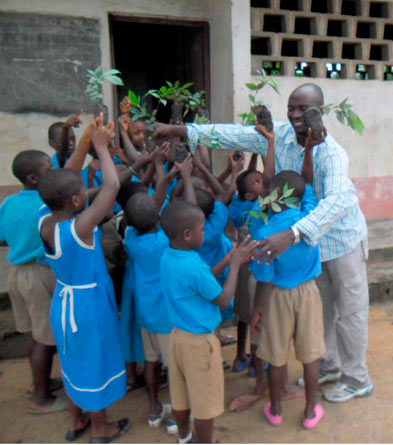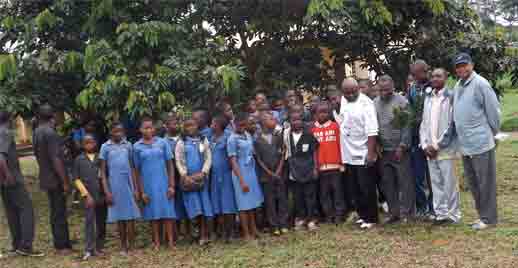Having been involved with the charity Rainforest Saver since its inception, I have always been conscious of how a relatively small charity, based in Edinburgh, can make a big difference to the lives and livelihoods of poor peasant farmers overseas. Yet the problem of tropical rainforest destruction can seem so huge, that I have also been conscious that however much RFS manages to raise, through the generosity and efforts of its supporters, there is so much more that could be done, if we only had a bit, or preferably a lot more money. I have always been interested in how the arts can help to raise the profile of issues, and possibly even attract more supporters to a cause and raise a few funds to add to the kitty. One only has to think of Live Aid to see how artists, if sufficiently inspired and engaged can come together to make a huge difference. Alas though, I’m not a famous musician with a bunch of famous musician contacts and friends, so Rainforest Aid might have to be put on hold for a while. Indeed, if I have any artistic talent, it lies merely in sometimes being able to string a few words together in a way that some people sometimes appreciate. I have always loved poetry (even at times if I didn’t really understand what the poet was going on about) and in recent years I have started writing it again. What I often enjoy doing is trying to write poems about subjects that might at first glance not seem so poetic, or even attempting to put into poetic form issues that might more sensibly be covered in an article or even a book. Trying to tell the story of Inga Alley Cropping and the creation and development of the charity Rainforest Saver probably falls into that second category. Yet poetry can sometimes connect with and reach people in a way that factual, even well written articles seldom can, and so I have decided to write a 24 hour poem on Facebook to try and raise the profile and some much needed finds for Rainforest Saver.
What poetry can sometimes do very well is tell
stories. One only has to think of ‘The Rhyme of The Ancient Mariner’ or ‘The
Ballad of Reading Jail’ to realize how effective it can be in both keeping the
reader in suspense, and relating tales that can haunt, fascinate and move the
heart and mind. Poems can also help to educate. I was helped to read by that
wonderful book The Cat in the Hat, which in a very funny way made the challenge
of deciphering the letters a very enjoyable task . Many people know that
tropical forests are being destroyed for timber or to plant palm oil, or to
clear space for roads or mines or cattle, but not so many realize that they are
also being destroyed by millions of poor peasant farmers, who are merely trying
to feed their families. What I find so wonderful about the Inga Alley Cropping
Ssytem is that it both offers these poor farmers a chance to obtain better
harvests and a more secure future, and ensures that more of the precious
rainforests, so vital for preventing erosion, storing carbon and preserving
biodiversity, are left intact. If my poem can in some way get across how
remarkable that is, I will feel I’ve at least partially succeeded.
Of course the other measure of success will be how
close I come to my fundraising target. I realized it was a bit ambitious when I
set it, yet had previously done a 24 hour Facebook poem for RFS and raised over
£500, so I considered my £1,000 target at least feasible. After all, didn’t I
now know so many more people that cared about green issues, many of who’m I
also counted as friends. What I perhaps failed to take into account though was
the time in which I was asking for money. The midst of a global pandemic, in
which the economic future for numerous people is worrying and uncertain, is
perhaps not the best time to start pestering people with my RFS begging bowl.
Yet when this awful pandemic is finally over, I trust that most people I know
in the UK will still have a roof over their heads and be able to put food on
the table. We are right to be worried about our own future, but if Covid 19 has
taught us anything, it is that when it comes to nature, we are all very much
connected. If the tropical peasant farmers continue to destroy the land,
they’ll have no choice but to move to the shanty towns in the cities. The land
they farmed will have been stripped of trees, leaving only barren wastelands
under which impoverished villages will be more likely to flood. That vital
store of carbon will have all been burnt away, and who knows how much the dread
factor of global warming will have been accelerated. So, is it not worth
supporting this gardener-poet, for all funds raised will go to try and ensure
this nighmare scenario on numerous tropical hillsides doesn’t happen. Such an
outcome will not only affect poor farmers and their families, but will increase
the chances of more of us, wherever we are in the world, experiencing more
severe droughts, fires and floods.
Yet, having visited some hillsides in Honduras, I
prefer to imagine a very different scenario. Inga Alley Cropping can give poor
farmers a chance to grow food in a sustainable, organic way in landscapes that
are both beautiful and biodiverse. If I’m ever lucky enough to have
grandchildren, I would like them to visit a Honduran, Ecuadorian or Cameroonian
Inga Farm, not only to maybe buy some delicious fruit and vegetables, but also to
experience the wonder of the rainforests with their parrots, toucans, monkeys,
snakes and butterflies. All of us have the power to either save or destroy
these vital treasure-chests of biodiversity. It is the farmers though, if they
are given the support and opportunity that can help stem the tide of
destruction. So, if you can afford anything, please donate to my forthcoming
poem. All donors will receive a copy of the finished work with a few added
pictures thrown in. One of the great things about writing poetry is that it’s a
lot easier than trying to farm infertile tropical hillsides.









